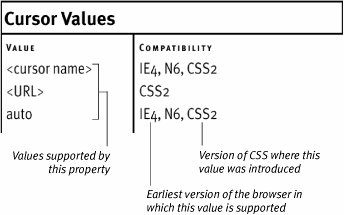Reading this Book
| For the most part, the text, tables, figures, code, and examples should be self-explanatory. But you need to know a few things to understand this book. CSS Value TablesIn Part 1, each section that explains a CSS property includes a table for quick reference with the different values the property can use, as well as the browsers and CSS levels with which those values are compatible (Figure i.2). The Compatibility column displays the first browser version that supported the value type. Table i.5 lists the browser abbreviations used in this book. Keep in mind, though, that even if the value is available in a particular version of the browser, it may not be available for all operating systems. The support Web site (webbedenvironments.com) has tables that show in which operating systems values work and whether there are any problems.
Figure i.2. The property tables in Part 1 of this book show you the values available with a property, the earliest browser version in which the value is available, and with which version of CSS the value was introduced. The CodeFor clarity and precision, this book uses several layout techniques to help you see the difference between the text of the book and the code. Code looks like this: <style> p { font-size: 12pt; } </style>All code in this book is presented in lower-case (see the sidebar "Uppercase or Lowercase Tags" in Chapter 1). In addition, quotes in the code always appear as straight quotes (" or '), not curly quotes (" or '). There is a good reason for this distinction: Curly quotes (also called smart quotes) will cause the code to fail. When you type a line of code, the computer can run the line as long as needed, but in this book, lines of code have to be broken to make them fit on the page. When that happens, you'll see a gray arrow
Production: please add arrows above. I often begin a numbered step with a line of code in red from the main code block. This is intended as a reference to help you pinpoint where that step applies in the larger code block that accompanies the task. This code will then be highlighted in red in the code listing to help you more easily identify it.
|
EAN: 2147483647
Pages: 230

 , indicating that the line of code is continued from above, like this:
, indicating that the line of code is continued from above, like this: